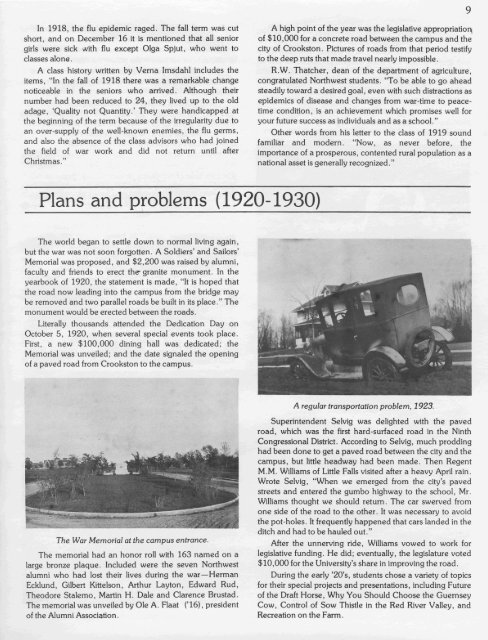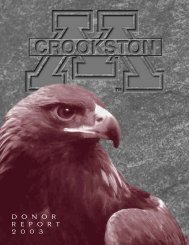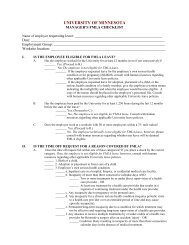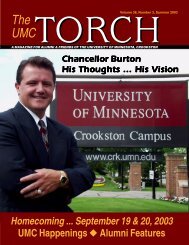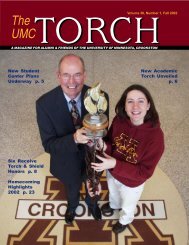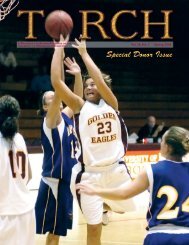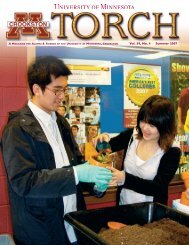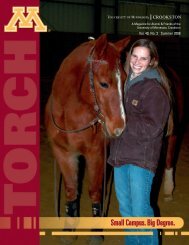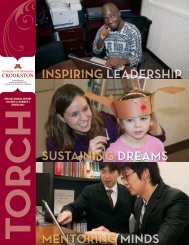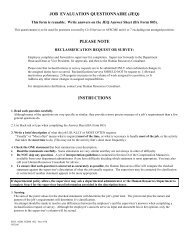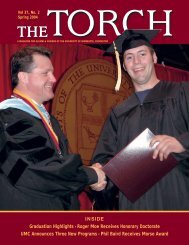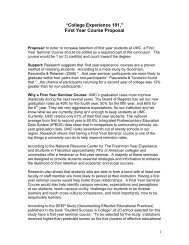8The first war years (1917-1919)On April 2, 1917, President Woodrow Wilson appearedbefore Congress to discuss the impending war withGermany. "God helping her, she (our country) can do noother," he said.By 1918, the "war to end all wars" was beginning to befelt even in rural <strong>Minnesota</strong>, and the yearbooks <strong>of</strong> 1918 and1919 paint a picture <strong>of</strong> the feelings and events during thosedays <strong>of</strong> the first global conflict.In his March 18 letter to the class <strong>of</strong> 1918, NorthwestSchool Superintendent, C. G. Selvig, quotes CorporalHerbert V. Anderson, a 1917 Northwest School graduate.Anderson wrote, "I hope the graduates will realize theresponsibility that is placed on them to apply the knowledgethey have learned at school. They are, to a certain extent,responsible for our keeping. It would be quite impossible forus to be here (at the front, in France) if the farmers <strong>of</strong>America didn't produce enough food. If the graduates applywhat they have learned, then we will be able to do the restwhich will bring peace and honor to all mankind."An entire section focuses on World War I in the 1918edition <strong>of</strong> the Red River Aggie. Forty-eight names werelisted under "Northwest School's Boys in Uncle Sam'sService."Military drill waspart <strong>of</strong> early regimen.Two drill companies were formed on campus, andPatriotic Day was observed on December 19, 1917. Thedominant theme was "save, serve and sacrifice."A flag service dedication took place at the school inFebruary <strong>of</strong> 1918, and was called "the most concretedemonstration <strong>of</strong> the Institution's genuine loyalty."During the week <strong>of</strong> February 11, students presented theNorthwest Farmers' Week. With the Farm Crops Show andLivestock Exhibit (forerunner to the Winter Shows), plus theFarmers' Week, the rapid development <strong>of</strong> agriculture in theRed River Valley was given a boost by providing informationjust for farmers. Patriotism was stressed throughout thesessions. "Farm, home and community problems werediscussed only in their relation to service to our country andour allies," yearbook writers noted.But not all <strong>of</strong> the 1917-18 year was spent contemplatinga war in far-<strong>of</strong>f Europe. Students viewed Mary Pickford in"The Little Princess," and basketball games were playedregularly.By 1917, there was a teachers' training course, whichgave practical experience in teaching and directinghousehold art and domestic science work in modern ruraland consolidated schools. TI:l8 course had begun in 1913,allowing qualified students to continue training at theNorthwest School to prepare for college. Eleven personswere enrolled in that advanced course and in others <strong>of</strong>feredfor post-graduates.Twenty-two seniors graduated in 1918. The freshmanclass was the largest yet-comprised <strong>of</strong> 118 members.By the time the 1919 yearbook went to press, thesobering fact <strong>of</strong> war had made an impression. That year, theannual was dedicated to Northwest alumni who had"answered the call <strong>of</strong> duty and gave their lives that Americamight live." The service flag now had 135 stars representinggraduates <strong>of</strong> the Northwest School who served during thewar. Most stars were blue; seven were gold. Five graduateshad died in France, and two in Army camps died from thepneumonia epidemic that ravaged the nation in 1918.Superintendent Selvig wrote a letter to the "Boys <strong>of</strong> theHonor Roll." Despite the verbal extravagance <strong>of</strong> the time,his letter apparently came from the heart. "You'felt Americameant something to you and to the millions you representedand you were willing to <strong>of</strong>fer any sacrifice to make thismeaning true. What a proud record you and your comradeshave emblazoned for the land that gave you birth. When thenews <strong>of</strong> the Allies' successful advances came in the fall <strong>of</strong>1918 we at home knew that some <strong>of</strong> you were in the line <strong>of</strong>battle with the flag floating proudly before you. We knew,too, that you would not come back till it was over 'overthere'."Servicemen's letters were reprinted on two pages. Somewrote detailed facts <strong>of</strong> life on the battlefield, some paintedgruesome pictures <strong>of</strong> the casualties, some merely said theywere lonely. A letter from Germany on December 28 tracedone soldier's past few months, beginning with going into thetrenches from March until May. He finished, "Some <strong>of</strong> thehottest fighting <strong>of</strong> the war was done between November Ill. We went over the top about two hours before theArmistice was signed."Girls' basketball team, 1916.
9In 1918, the flu epidemic raged. The fall term was cutshort, and on December 16 it is mentioned that all seniorgirls were sick with flu except Olga Spjut, who went toclasses alone.A class history written by Verna Imsdahl includes theitems, "In the fall <strong>of</strong> 1918 there was a remarkable changenoticeable in the seniors who arrived. Although theirnumber had been reduced to 24, they lived up to the oldadage, 'Quality not Quantity.' They were handicapped atthe beginning <strong>of</strong> the term because <strong>of</strong> the irregularity due toan over-supply <strong>of</strong> the well-known enemies, the flu germs,and also the absence <strong>of</strong> the class advisors who had joinedthe field <strong>of</strong> war work and did not return until afterChristmas."A high point <strong>of</strong> the year was the legislative appropriatio~<strong>of</strong> $10,000 for a concrete road between the campus and thecity <strong>of</strong> <strong>Crookston</strong>. Pictures <strong>of</strong> roads from that period testifyto the deep ruts that made travel nearly impossible.R.W. Thatcher, dean <strong>of</strong> the department <strong>of</strong> agriculture,congratulated Northwest students. "To be able to go aheadsteadily toward a desired goal, even with such distractions asepidemics <strong>of</strong> disease and changes from war-time to peacetimecondition, is an achievement which promises well foryour future success as individuals and as a school."Other words from his letter to the class <strong>of</strong> 1919 soundfamiliar and modern. "Now, as never before, theimportance <strong>of</strong> a prosperous, contented rural population as anational asset is generally recognized."Plans and problems (1920-1930)The world began to settle down to normal liVing again,but the war was not soon forgotten. A Soldiers' and Sailors'Memorial was proposed, and $2,200 was raised by alumni,faculty and friends to erect the- granite monument. In theyearbook <strong>of</strong> 1920, the statement is made, "It is hoped thatthe road now leading into the campus from the bridge maybe removed and two parallel roads be built in its place." Themonument would be erected between the roads.Literally thousands attended the Dedication Day onOctober 5, 1920, when several special events took place.First, a new $100,000 dining hall was dedicated; theMemorial was unveiled; and the date signaled the opening<strong>of</strong> a paved road from <strong>Crookston</strong> to the campus.The War Memorial at the campus entrance.The memorial had an honor roll with 163 named on alarge bronze plaque. Included were the seven Northwestalumni who had lost their lives during the war-HermanEcklund, Gilbert Kittelson, Arthur Layton, Edward Rud,Theodore Stalemo, Martin H. Dale and Clarence Brustad.The memorial was unveiled by Ole A. Flaat ('16), president<strong>of</strong> the Alumni Association.A regular transportation problem, 1923.Superintendent Selvig was delighted with the pavedroad, which was the first hard-surfaced road in the NinthCongressional District. According to Selvig, much proddinghad been done to get a paved road between the city and thecampus, but little headway had been made. Then RegentM.M. Williams <strong>of</strong> Little Falls visited after a heavy April rain.Wrote SelVig, "When we emerged from the city's pavedstreets and entered the gumbo highway to the school, Mr.Williams thought we should return. The car swerved fromone side <strong>of</strong> the road to the other. It was necessary to avoidthe pot-holes. It frequently happened that cars landed in theditch and had to be hauled out."After the unnerving ride, Williams vowed to work forlegislative funding. He did; eventually, the legislature voted$10,000 for the <strong>University</strong>'s share in improving the road.During the early '20's, students chose a variety <strong>of</strong> topicsfor their special projects and presentations, including Future<strong>of</strong> the Draft Horse, Why You Should Choose the GuernseyCow, Control <strong>of</strong> Sow Thistle in the Red River Valley, andRecreation on the Farm.


